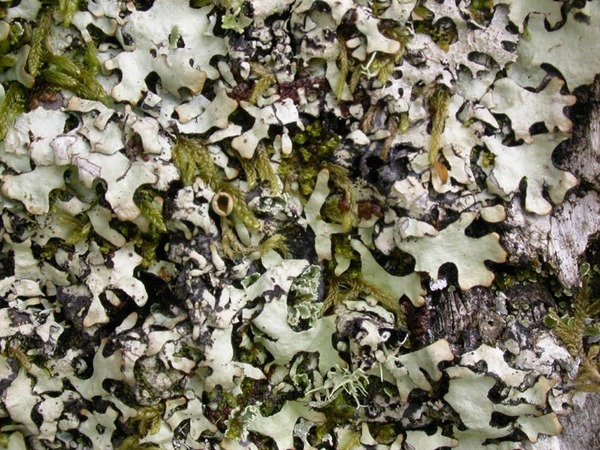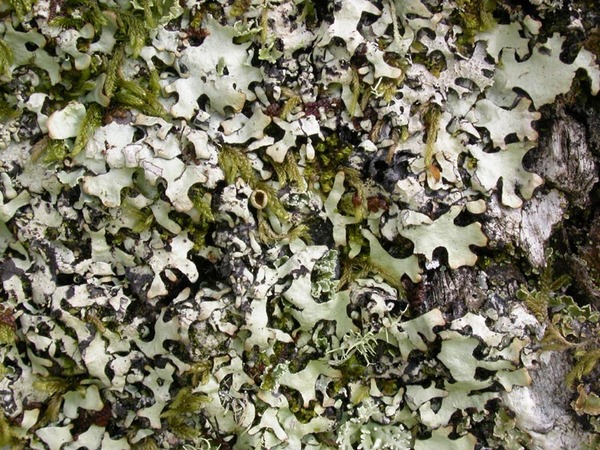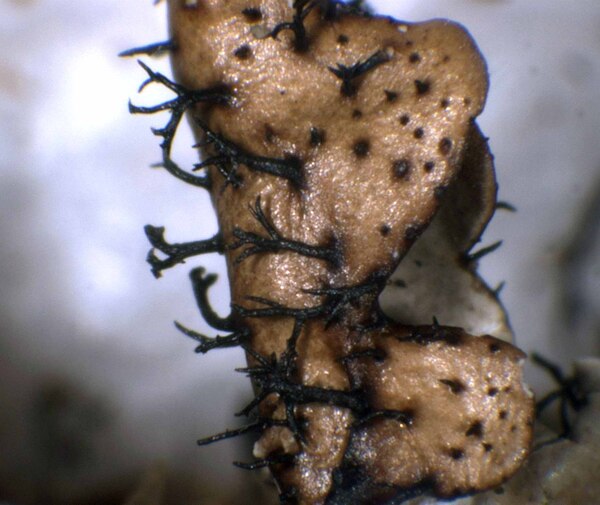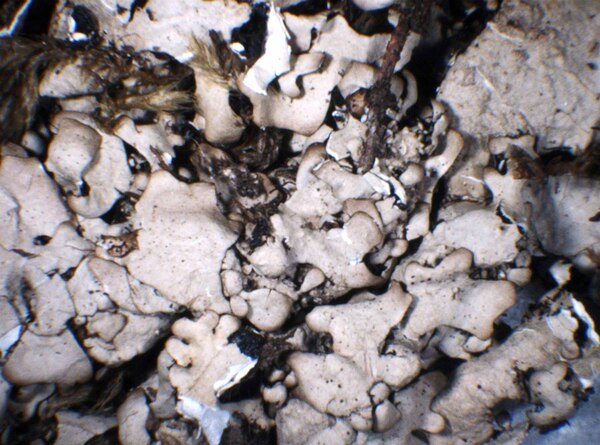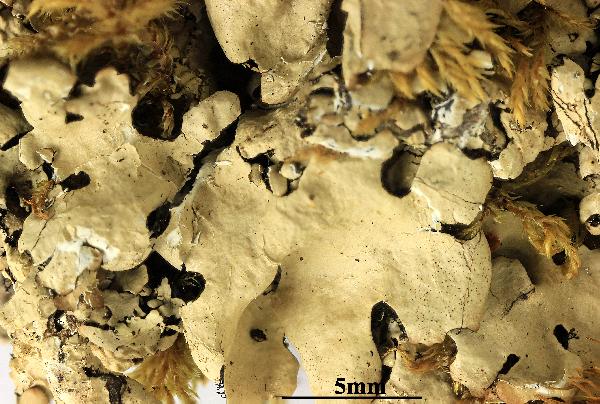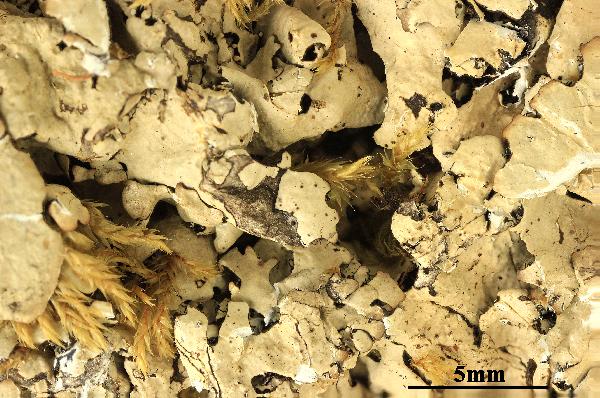Hypotrachyna taylorensis (M.E. Mitch.) Hale
Phytologia, 28: 342, 1975 (1974). Basionym: Parmelia taylorensis M.E. Mitch. - Rev. de Biol., 2: 215, 1961.
Synonyms: Parmelia rugosa Taylor
Distribution: N - Lomb, Piem (TSB 25777).
Description: Thallus foliose, heteromerous, dorsiventral, ash-grey, loosely attached, forming orbicular to irregular, up to 15 cm wide patches. Lobes dichotomously to irregularly branched, with rounded axils and down-turned margins, overlapping and often imbricate, (1-)2-6(-8) mm wide; upper surface pale ash-grey, more or less distinctly white-maculate, sometimes pruinose at lobe-tips, the upper cortex tending to flake-off into small, flattened schizidia, exposing the white to blackish medulla; soralia rarely present, pustular, laminal, more or less maculiform, with whitish granulose soredia; lower surface dark brown near margins, otherwise black and shiny, with shiny, richly dichotomously branched rhizines which sometimes project beyond lobe margins. Upper cortex of tightly packed, anticlinally oriented hyphae, with a pored epicortex, the cell walls with isolichenan; medulla white; lower cortex brown, of anticlinally oriented hyphae. Apothecia very rare, lecanorine, laminal, up to 5 mm across, with a brown disc and a crenulate thalline margin. Epithecium brownish; hymenium and hypothecium colourless. Asci 8-spored, clavate, Lecanora-type. Ascospores 1-celled, hyaline, broadly ellipsoid to subglobose, 9-14 x 6-10 µm. Pycnidia rare, black, immersed. Conidia bacilliform, wider at one or both ends, 4-5 x c. 1 μm. Photobiont chlorococcoid. Spot tests: upper cortex K+ yellow, C-, KC-, P- or P+ faintly yellow; medulla K-, C+ pink, KC+ pink-red, P-, UV+ bluish white. Chemistry: upper cortex with atranorin; medulla with lecanoric and evernic acids.Note: a mild-temperate, mostly oceanic species found on mossy trunks in ancient, undisturbed, moist forests. It is included as “Regionally Extinct” in the Italian red list of epiphytic lichens (Nascimbene & al. 2013c).
Growth form: Foliose, broad lobed
Substrata: bark
Photobiont: green algae other than Trentepohlia
Reproductive strategy: mainly asexual, by soredia, or soredia-like structures (e.g. blastidia)
Restricted to humid-warm, oceanic areas
Commonnes-rarity: (info)
Alpine belt: absent
Subalpine belt: absent
Oromediterranean belt: absent
Montane belt: extremely rare
Submediterranean belt: absent
Padanian area: absent
Humid submediterranean belt: absent
Humid mediterranean belt: absent
Dry mediterranean belt: absent
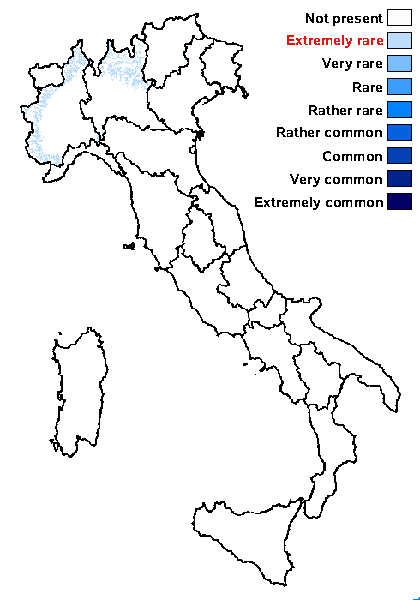
Predictive model
Herbarium samples
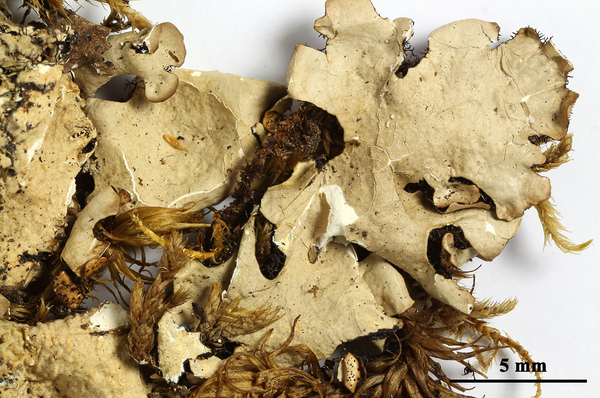

Felix Schumm - CC BY-SA 4.0
[20338], Magna Britannia, Cambria, Merionethshire, Penmaenpool, ad murum vetustum. Annot.: Atranorin, evernic acid, lecanoric acid by TLC - A. Johnson and C.F. Culberson (no. 3554). Leg. W.L. Culberson (no 14069) & C.F. Culberson, 23.07.1964. A. VEZDA: LICHENES SELECTI EXSICCATI NR. 1738
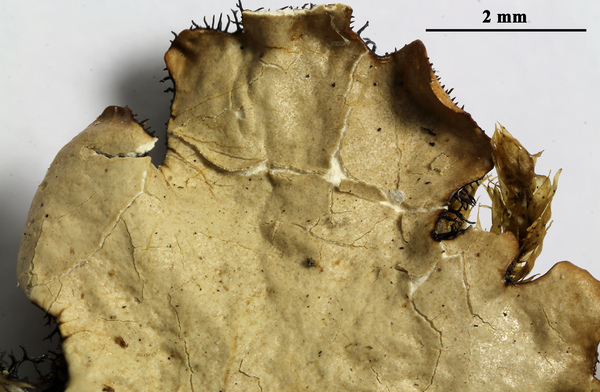

Felix Schumm - CC BY-SA 4.0
[20338], Magna Britannia, Cambria, Merionethshire, Penmaenpool, ad murum vetustum. Annot.: Atranorin, evernic acid, lecanoric acid by TLC - A. Johnson and C.F. Culberson (no. 3554). Leg. W.L. Culberson (no 14069) & C.F. Culberson, 23.07.1964. A. VEZDA: LICHENES SELECTI EXSICCATI NR. 1738
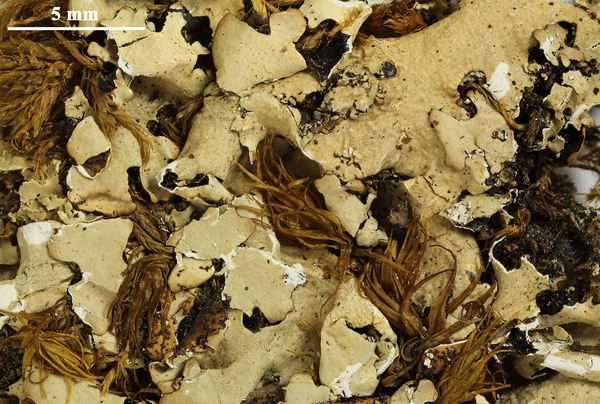

Felix Schumm - CC BY-SA 4.0
[20338], Magna Britannia, Cambria, Merionethshire, Penmaenpool, ad murum vetustum. Annot.: Atranorin, evernic acid, lecanoric acid by TLC - A. Johnson and C.F. Culberson (no. 3554). Leg. W.L. Culberson (no 14069) & C.F. Culberson, 23.07.1964. A. VEZDA: LICHENES SELECTI EXSICCATI NR. 1738
Growth form: Foliose, broad lobed
Substrata: bark
Photobiont: green algae other than Trentepohlia
Reproductive strategy: mainly asexual, by soredia, or soredia-like structures (e.g. blastidia)
Restricted to humid-warm, oceanic areas
Commonnes-rarity: (info)
Alpine belt: absent
Subalpine belt: absent
Oromediterranean belt: absent
Montane belt: extremely rare
Submediterranean belt: absent
Padanian area: absent
Humid submediterranean belt: absent
Humid mediterranean belt: absent
Dry mediterranean belt: absent

Predictive model
| Herbarium samples |


Felix Schumm - CC BY-SA 4.0
[20338], Magna Britannia, Cambria, Merionethshire, Penmaenpool, ad murum vetustum. Annot.: Atranorin, evernic acid, lecanoric acid by TLC - A. Johnson and C.F. Culberson (no. 3554). Leg. W.L. Culberson (no 14069) & C.F. Culberson, 23.07.1964. A. VEZDA: LICHENES SELECTI EXSICCATI NR. 1738


Felix Schumm - CC BY-SA 4.0
[20338], Magna Britannia, Cambria, Merionethshire, Penmaenpool, ad murum vetustum. Annot.: Atranorin, evernic acid, lecanoric acid by TLC - A. Johnson and C.F. Culberson (no. 3554). Leg. W.L. Culberson (no 14069) & C.F. Culberson, 23.07.1964. A. VEZDA: LICHENES SELECTI EXSICCATI NR. 1738


 INDEX FUNGORUM
INDEX FUNGORUM
 GBIF
GBIF
